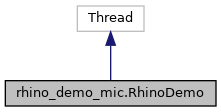Inheritance diagram for rhino_demo_mic.RhinoDemo:

Public Member Functions | |
| def | __init__ (self, access_key, library_path, model_path, context_path, require_endpoint, audio_device_index=None, output_path=None) |
| def | run (self) |
| def | show_audio_devices (cls) |
Private Attributes | |
| _access_key | |
| _audio_device_index | |
| _context_path | |
| _library_path | |
| _model_path | |
| _output_path | |
| _require_endpoint | |
Detailed Description
Microphone Demo for Rhino Speech-to-Intent engine. It creates an input audio stream from a microphone, monitors it, and extracts the intent from the speech command. It optionally saves the recorded audio into a file for further debugging.
Definition at line 21 of file rhino_demo_mic.py.
Constructor & Destructor Documentation
◆ __init__()
| def rhino_demo_mic.RhinoDemo.__init__ | ( | self, | |
| access_key, | |||
| library_path, | |||
| model_path, | |||
| context_path, | |||
| require_endpoint, | |||
audio_device_index = None, |
|||
output_path = None |
|||
| ) |
Constructor. :param access_key: AccessKey obtained from Picovoice Console (https://console.picovoice.ai/). :param library_path: Absolute path to Rhino's dynamic library. :param model_path: Absolute path to file containing model parameters. :param context_path: Absolute path to file containing context model (file with `.rhn` extension). A context represents the set of expressions (spoken commands), intents, and intent arguments (slots) within a domain of interest. :param require_endpoint If set to `False`, Rhino does not require an endpoint (chunk of silence) before finishing inference. :param audio_device_index: Optional argument. If provided, audio is recorded from this input device. Otherwise, the default audio input device is used. :param output_path: If provided recorded audio will be stored in this location at the end of the run.
Definition at line 28 of file rhino_demo_mic.py.
Member Function Documentation
◆ run()
| def rhino_demo_mic.RhinoDemo.run | ( | self | ) |
Creates an input audio stream, instantiates an instance of Rhino object, and infers the intent from spoken commands.
Definition at line 57 of file rhino_demo_mic.py.
◆ show_audio_devices()
| def rhino_demo_mic.RhinoDemo.show_audio_devices | ( | cls | ) |
Definition at line 147 of file rhino_demo_mic.py.
Member Data Documentation
◆ _access_key
|
private |
Definition at line 47 of file rhino_demo_mic.py.
◆ _audio_device_index
|
private |
Definition at line 52 of file rhino_demo_mic.py.
◆ _context_path
|
private |
Definition at line 50 of file rhino_demo_mic.py.
◆ _library_path
|
private |
Definition at line 48 of file rhino_demo_mic.py.
◆ _model_path
|
private |
Definition at line 49 of file rhino_demo_mic.py.
◆ _output_path
|
private |
Definition at line 54 of file rhino_demo_mic.py.
◆ _require_endpoint
|
private |
Definition at line 51 of file rhino_demo_mic.py.
The documentation for this class was generated from the following file: